
Content
Welcome to the Club of Amsterdam Journal.
India faces challenge in all these three fronts. It may appear we have plenty of water but the extreme nature of spread and distribution make it uneven in terms of availability and accessibility. In addition, more than 70% of al health related issues in India are water borne. Hence delivery of right quantity of right type of water is the utmost priority in any developmental activity. Due to pressure on land and natural resources, the external environment faces rather various degree of endanger related to air, water and soil. Urbanisation is growing fast and development of civic facility needs equally a fast action. While the general feeling of sustainability of development keeping in mind the totality of environment has been a governmental and social policy, there are several instances of mismatch leading to conflict – social, legal as well as political.
The latest thinking on development is not just sustainability but that aspects and approach that will leave a very low carbon footprint. Responsible industrial investment will need to recognize this aspect while taking decisions so that only what is locally sustainable in the long run at the same time leave negligible carbon foot print should be attempted. While globalization has brought the world closer almost like borderless Western Europe this has also thrown open responsibility on each one to keep the environment clean for future generations as well. To quote Mahatma Gandhi, we have enough for everyone’s needs but not for everybody’s greed!– V. Subramanian, Professor, School of Environmental Sciences, Jawaharlal Nehru University, New Delhi, India, Senior central government advisor on technology development and assessment
Professor V. Subramanian is a speaker at our next Season Event about Taste of Diversity – the future of INDIA
Thursday, July 3, 2008
Felix Bopp, editor-in-chief
Technology and Rural Development, a case in perspective,

Arnab B. Chowdhury is founder and CEO of Ninad ~ an e-Learning consulting firm centered on Integrality.
Clad in a traditional south Indian cotton sari, 48 year old Rajeswari Rao Pingali looks hardly the regular perseverant social development practitioner, who had taken on herself to make a difference in the villages of the Mahbubnagar District in the state of Andhra Pradesh, India.
The challenges at hand are enormous. All rural areas in India face problems; whether they are specific challenges like disasters or more generic in nature like a lack of information and knowledge on global developments and their impact on their daily lives. Initially, Rajeswari started her not-for-profit organisation “Villages in Development and Learning Foundation” (ViDAL, www.vidal.org.in) in 2004 to look at the issues of knowledge and plug in information deficiencies for arresting farmer suicides, having worked in suicide prevention for over a decade by then. However, as the years passed by, her sense of rural needs changed and now she thinks the problem of rural development and self-reliance is in the inadequate number of people who have development as their personal goal at the village level. She has keen interest in latest technologies and gadgets and knows these are necessary for hastening the pace of development. At a personal level her engagement with the people is much deeper and not centred around any specific need especially where she is engaged in streamlining the thought process of people in the village communities.
Currently ViDAL is working with technology and youth who are keen on developing themselves as well as their communities. The focus is to enhance their learning ability, critical capacity and help them become the torchbearers of positive change. This way Rajeswari believes we can avoid “intrusion”. In her words, “no matter what, we are alien and don’t belong in the villages. Their culture, traditions and above all the social norms are so different from ours. They accept us because they are generous, that does not automatically make us one of them”.

Incidentally, COW began as an ICT project that Rajeswari found in Stanford Reuters Digital Vision Program, Stanford University, as an inaugural fellow. COW’s unique position is in its last-mile-reach-out with electronic and telecommunication ability that is also applicable in isolated rural and tribal habitations. This is achieved with the unique integration of software and hardware at its rugged best in the form of a hybrid motorbike. It has a platform fitted at the rear of the motorbike on which is mounted a weather and shock-proof, solar powered equipment case which carries and recharges a laptop, a printer, a wireless phone and a camera. It also has a portable tent for impromptu meetings in open fields. In addition, the laptop has an Open Source-based software suite that offers varied information depending on the needs of people in the villages (like hygiene and healthcare, agricultural credit, weather, rainfall, pest control, soil testing, availability of seeds at subsidised prices, and crop prices in local markets etc.). Its ‘drivers’ are the Information Providers (IPs) – village youth who are carefully selected to be service entrepreneurs.
The project started in Andhra Pradesh, a southern state and moved to Uttar Pradesh, a northern state in the country, with unique lessons to offer from a private sector perspective and from developmental perspectives. COW won the World Bank Development Market Place award for the year 2003, was a finalist for Stockholm Challenge Global Award for the year 2006 and for Computerworld honors for the year 2002.
Currently COW functions as a platform to engage village folk with academia and technologists for ideating appropriate innovations for rural development. ViDAL aims to be a “centre of excellence” that has knowledge and ability to guide rural development for the bottom 15% people on the economic ladder. In this role ViDAL is going to be a place of innovation, incubation and mainstreaming of ideas, technologies and innovative approaches. Rajeswari’s small effort found feet with several other like-minded people who collaborate with her, virtually as well as in person, at the field level, which is opening up new dimensions in addressing immediate and urgent as well as long-term issues for rural development.
Impact in Numbers
Following are the details of services provided in a one year period by two COW information providers.
The total number of people who approached COW was about 4727 in one year, out of which about 2466 used COW services and about 1669 paid for the services.
Economic:
- Wage dispersal information about 2300 daily labourers was collected from 21 villages, which indicated discrepancies in the dispersals and led to changes in the processes by the government department.
- Photographic services were accessed for agriculture-related needs
Governmental:
- Cropping information about 1589 land records is being compiled to assess the cropping pattern in the region to divert farmers from cultivating water-intensive crops.
- Government entitlements were accessed by 56 poor households on a single day after submitting their credentials through COW.
- Photographic services were accessed for governance related requirements (for making civilian photo identity cards by the departments)
Health:
- Approximately 440 people accessed remote health services for myalgia, knee pains, skin problems and reproductive health problems in 7 villages.
- HIV Aids preventing audiovisual shows were effectively shown to specific target groups in 11 tribal habitations including women without causing embarrassment by the culturally sensitive information provider.
- In livestock, about 760 sheep were saved out of a total 9000 sheep that were there in about 7 villages.
- Photographic services were accessed for health-related needs
Education:
- In a span of 5 months close to 800 children accessed computer-aided education while 300 children paid a nominal amount for the service in village schools.
- 5 young adults learned computer literacy from the information providers from 2 villages. Photographic services were accessed a large number of times for family functions.
- 75 students accessed results of secondary grade exams via Internet from 7 villages.
Socio-cultural:
- Photographs were taken during 21 marriages by the information provider in a span of two months during the marriage season.
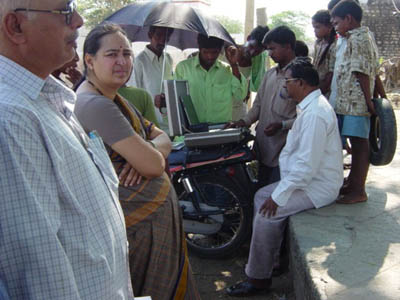

Next Event

Taste of Diversity – the future of INDIA
Thursday, July 3, 2008
Registration: 18:30-19:00, Conference: 19:00-21:15, Buffet: 21:15-23:30
Tickets also include Indian dishes and some drinks!
Where: Cultuurhuis Diamantslijperij, Tolstraat 129, 1074 VJ Amsterdam
former Royal Asscher Diamond Factory.
The speakers and topics are:
Ram L. Lakhina, Founder and Executive President of the Netherlands India Chamber of Commerce and Trade (NICCT)
India’s Unity in Diversity: Relevance for The Netherlands
Rajindre Tewari, Managing Director, Cordares Capital (APG Group)
Can the Indian Elephant Dance? Highlights and Opportunities of the Indian Economy
V. Subramanian, Professor, School of Environmental Sciences, Jawaharlal Nehru University, New Delhi, India
Senior central government advisor on technology development and assessment
Water, Environment, Technology and Development
Moderated by Hedda Pahlson-Moller, Managing Director, Evalueserve Benelux and Omnisource International
Supported by Qualit Datamatics and
Embassy of India, Global Food Funatics, The Netherlands-India Chamber of Commerce and Trade (NICCT), Evalueserve, Sichuan Foods, Innergy Creations, Kadarka and India Tourism Amsterdam
Club of Amsterdam blog

| Club of Amsterdam blog June 9 : Pakistan in the 21st Century: Vision 2030 May 24: Beyond Innovation May 24: What future coal? April 9: The Fall of the US Empire |
News about the Future

UV sun protection swimwear for boys and girls
Offered for the first time this summer, madeforsundays is a boutique Australian brand of fashionable, high quality UV sun protection swimwear for boys and girls up to the age of 4 years.
Inspired by motherhood, our outdoor lifestyle and the need to protect young children’s delicate skin from the harsh Australian sun, madeforsundays has created a collection of rash shirts, shorts and reversible bucket hats that provide high quality protection, design and comfort in bold hibiscus prints and bright coordinated colours.

Underwater communication: Robofish In the world of underwater robots, this is a team of pioneers. While most ocean robots require periodic communication with scientist or satellite intermediaries to share information, these can work cooperatively communicating only with each other. But while other research groups have developed fishlike robots, what’s novel with this system is that the robotic fish can communicate wirelessly underwater. Kristi Morgansen, a UW assistant professor of aeronautics and astronautics, looked to natural systems for inspiration. The engineers worked with collaborator Julia Parrish, an associate professor in the UW’s School of Aquatic and Fishery Sciences, to record patterns of fish schools’ behavior. “In schooling and herding animals, you can get much more efficient maneuvers and smoother behaviors than what we can do in engineering right now,” Morgansen explained. “The idea of these experiments [with schools of live fish] is to ask, ‘How are they doing it?’ and see if we can come up with some ideas.” |
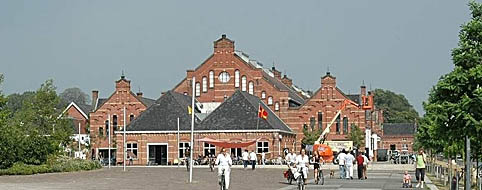
Westergasfabriek Amsterdam
If you’re looking for an adventurous place in Amsterdam, then the Westergasfabriek Culture Park is worth a visit. Art and culture form the basis of this down-to-earth industrial complex close to the centre of Amsterdam. The new energy is tangible for everyone who visits for work, play, exercise, entertainment or events.
Just about anything goes in these historic buildings; from a photo shoot to major audience events, from weddings to exclusive product presentations. The venues available for a temporary hire are: the magnificent circular Gasometer (2500 m2), the Transformer House with its sacred mood (700 m2), the impressive Purification Hall (1200 m2), the intimate Machine Building with chapel (340 m2) and the small Eastern Meter House (60 m2), furnished as a meeting room. The outdoor spaces such as the quayside, the larger meadow or the gardens of the park can also be used for events.
The Westergasfabriek is freely accessible all day. From early in the morning, there’s fresh bread and fine coffee at the Baker’s Shop (open every day) and the Espresso Factory (open tue – sun). There are various galleries and shops, Pacific Parc cafe/restaurant/dancing (open everyday) and the food-design studio Proef (open: fri-sun). The Ketelhuis Cinema (open everyday) shows the latest films and in the Flex Bar (open thu – sun) you can dance late in the night. Opening soon: The WestergasTerras for drinks, dinner, parties & salsa near the wetlands. The modern park surrounding the site offers plenty of space, peace and nature; for a picknick, to throw a frisby or a pleasant walk. You are most welcome.
Westergasfabriek / Pazzanistraat 41 / 1041 DB Amsterdam /
T: + 31 (0) 20 5860710 / F: + 31 (0) 20 6813062 /
E info@westergasfabriek.nl I www.westergasfabriek.com

Pakistan in the 21st Century: Vision 2030

By Shaukat Hameed Khan, Project Director, Vision 2030, Fellow, Pakistani Academy of Sciences
Introduction
A nation must know where it wants to go and what its vision for itself might be, only then can it prepare strategies and policies to reach there. The effort and set of rules needed to achieve such a vision would therefore depend strongly upon the height of one’s gaze. Pakistan, too, has to spell out a vision for itself, and then define its preferred future in an increasingly uncertain world.
The Medium Term Development Framework, 2005-10 (MTDF) emphatically states that Pakistan must become a developed, industrialized, just and prosperous nation within one generation. It must do so in a manner that sustains its development paradigm of a good quality of life and opportunity for all its citizens to reach their true potential. The MTDF also states, that in spite of resource constraints, Pakistan can reach the development levels which it needs and deserves, by deploying knowledge inputs and human capital. This is our Vision for Pakistan in the year 2030.
The time until 2030 represents the period of one generation, during which we have not only to place Pakistan firmly along proper alignments, but actually cross some critical milestones. Within these operating parameters, the Vision 2030 exercise examines future possibilities and subsequent strategic directions in order to manage and take advantage of ongoing global and societal transformations, and even to create new opportunities. This is the basic theme of Vision 2030.
Vision 2030 is ultimately about changing the mindset of a people so that the preferred future can be grasped from among the several futures that will be possible. It is a journey of exploration, which attempts to convert potential and dreams into reality. Given the nature, diversity and enormity of the challenges, this Vision Document outlines only the beginning of a comprehensive analytical process to determine the appropriate responses in order to provide authority, legitimacy and credibility to this foresight exercise.
The year 2030 is important for Pakistan in several respects. It is the year when a child entering the educational stream today will have become an important productive member of the society. It is the period when most analysts predict the beginning of an irreversible decline in oil production, which will allow only a few years for humanity to find alternative and sustainable sources of energy. It is the year when most of mankind is likely to be severely stressed between water scarcity and melting glaciers and polar caps. It is also the year when all demographic trends suggest that we in Pakistan too will start ageing as a society – with all the social and economic consequences of a fragmented family unit. We will face the additional danger, however, that unlike the countries of the richer West, we could start aging before we have grown rich as a nation.
Where Pakistan can and should, be placed in the middle of such major transformations is the focus of Vision 2030. In order to manage these global forces of change to Pakistan’s advantage, we must first understand their form and intensity, and then complement this knowledge with a vision for ourselves; the stance chosen, however, must be our own.
Growing at a rate of around 7-8 percent per annum Pakistan expects to join the ranks of middle-income countries, with a GDP of around USD 12,000 – 13,000 (in current PPP terms) by 2030. This high growth rate would be sustained through developing its human resources, and by developing the necessary physical and technological infrastructure.
The growth trajectory will gain momentum by the latent capacities of a sizable middle class emerging in the development process. Besides sustaining high growth rates, benefits of growth are planned to be equitably distributed, and poverty largely eliminated, through pro-poor policies.
Predicting where a nation might be a generation hence is an uncertain exercise. A vision, however, represents more than mere predictive numbers and statistics. It spells out the dreams, hopes, and aspirations of a nation and the desire to lead a better and fuller life. It is completed when our hopes for well-being for our own selves are realised at the same time as the world is freed from conflict, disease and hunger.
The Vision 2030 document has been prepared, after a consultative process spread over two years with some of our best minds and hearts in the country.
The Consensus
The future is essentially unpredictable, with a range of possible futures for Pakistan, influenced by internal and external factors and path-breaking events or innovations. The future is, however, predictable to the extent that economic globalisation and dispersion of information and technology will have occurred to such a massive extent, that it will change the scale and nature of human enterprise. Based on changes that have already taken place in recent decades, we can safely assume that by 2030, the way we live, work and educate ourselves, or compete and trade, and the manner in which we grow old and become sick, would have been completely transformed.
In spite of often divergent and always passionate views and opinions, there is a remarkable consensus among all national stakeholders about the possible state of affairs for Pakistan. Everyone agrees the country is neither too small nor too poor to be irrelevant, nor is its population too large to pull it down. It has, however, reached a certain ‘tipping point’, when the right choices and their intelligent calibration can help Pakistan attain its historical promise, while the wrong choices will revert it to a state of ‘muddling through’ at best. Alternatively, it could benchmark itself against the best of the world with felicity and confidence and attain its true potential. This transformation therefore offers vast opportunities as well as challenges for Pakistan.
All strategies and action matrices to be drawn up for Pakistan reaching the desired state under the Vision 2030 must be subservient to the overarching objective of becoming a vibrant knowledge economy. The economics of knowledge must therefore underpin policies for growth. Since many other nations are also embarking on the path of either enhancing their existing knowledge drivers or becoming similar knowledge driven societies, Vision 2030 is as much about Pakistan and Pakistanis competing with other nations, as it is about internal transformation.
Vision 2030 is all about managing such a transition. It calls for a quest for excellence, so that Pakistan can redefine and transform its institutions and structures of the state, as well as national policies, strategic priorities and long-term benchmarks, within the overarching Vision for Pakistan in 2030.
There is consensus on the following:
- Build a nation whose development is measured not through mere statistics of economic growth but by the quality of life of all its people, especially the vulnerable and dispossessed, who must be placed at the centre of national development.
- Evolve into a mature, tolerant, and democratic society, which is developed economically and socially, and is at peace with itself and with the rest of the world, within a framework of assured sovereignty and security.
- Establish a social, economic and political system based on rule of law which alone will assure justice and equity. It will be reflected in a shared destiny and prosperity, brought about by a series of ‘public goods’, and participation and equal opportunities for all, irrespective of geographical and ethnic origin, creed, gender, or age.
- Sustain an average growth of at least 6 -7 per cent until 2030 to meet the development goals. Without high growth, there will be no poverty reduction, or improvement in the quality of life.
- Make employment and employability the central theme in economic and social policies. This requires major social reforms to draw in women, since labour markets are always socially embedded.
- Re-assume greater responsibility for the delivery and provision of certain basic services and facilities of acceptably high quality to all citizens. These would cover 10 years of schooling, healthcare, food, water, shelter, and energy, apart from security under law.
- Re-design the structures of state and instruments of government, so that these are responsive to an educated and demanding population in terms of participation, delivery of services, and good governance. Pakistan has reached the ‘tipping point’ which stipulates that we cannot afford any longer not to have good institutions.
- Attain rapid and sustainable growth, through the use of knowledge and technology inputs, to create opportunities for increased productivity and competitiveness, within the constraints imposed by depleting resources.
- Become an intelligent and efficient exploiter of globalisation through enhanced competitiveness, whether it relates to commerce, manufacturing, or services, or increased diversity and technology content. A necessary corollary is the emergence of “Brand Pakistan”, with several large conglomerates becoming global players, and many more regional hubs and centres established in Pakistan.
- Generate knowledge and manage it in all its forms. This would focus on science and technology because science and technology not only makes change possible, but also provides tools for managing this transition; there must be equal focus on the social sciences, the humanities, and the arts, which provide the human face to science and technology .
- Prepare for the demographic transition towards an increasingly aging population by ensuring that its dividends should be exploited, and the threat of a low skills population is avoided.
- Manage the current and looming intense competition for access and ownership of depleting resources and energy, which will increase Pakistan’s vulnerabilities in its transition towards a high level of sustained growth over the long term.
- Prepare for climate changes, and its accompanying uncertainties.
- Minimise wastage as an important tool for preserving inter-generational equity while exploiting current resources.
- Prepare for and manage the very predictable state of future societies which will be reflected in the growth of large cities, urban concentrations and considerable internal and intra-national migrations. These will have dynamics and imperatives of their own in all spheres of human activities.
If this transition is brought about successfully, we can aspire to become an influential nation of the 21st century. It will be a nation that has achieved competence in technology, and a nation which draws upon its rich past to become modern, developed, just and affluent, while remaining uniquely Pakistani in character.
| Pakistan in 2030 In 2030, Pakistan will be the world’s fifth most populous country with an estimated 230 to 260 million people. It will emerge as a major economic power, and will be ranked among the top twenty countries on the basis of a 7-8 percent sustained growth. Its GDP is expected to be $1000 billion, with per capita incomes of around USD 13,000 in current PPP terms. Pakistanis will enjoy a high quality of life in both rural and urban areas. Absolute poverty will be largely eliminated, and social protection will be available to every citizen. Its people in the under-25 age group will have an average of 10 years of education, while tertiary enrolments will grow to 20 percent of the 17-23 years age cohort. Pakistan will be transformed into a knowledge-based economy, harnessing technology to its advantage. The innovation, productivity, and enterprise of its people, in the context of appropriate economic and social environment, will make Pakistan a major regional hub for industry, education, services and the arts. Pakistan will have taken its first steps in space, having earlier launched its own communication and resource mapping satellites, and manned space modules. Pakistan will be an active player in regional and international cooperation, with a competitive enabling environment for innovation and investment.Pakistan will be a just and prosperous society, at peace with itself and the rest of the world. |
Read the Executive Summary click here
Recommended Book

The Rise of India: Its Transformation from Poverty to Prosperity
by Niranjan Rajadhyaksha (Author)
| The Risk of India: Its Transformation from Poverty to Prosperity is an extremely interesting read. The book speaks not only to the mind and intellect but also to the heart as it clearly demonstrates that economic development is above all a question of people. It also shows that the Indian society, and particularly its youth, is much more open to changes than its political and bureaucratic class, and would welcome a third wave of reforms that would help the poor to benefit from economic progress. I stronglyrecommend this book. It offers a very unique and rich description of today’s India from the author’s perspective and many well chosen anecdotes. – Colette Mathur, Director World Economic ForumThis fascinating work weaves together a set of seemingly diverse events into an intricate tapestry capturing the essence and purpose of emerging India. It is also an inspiration to people in “Challenged” economies that the power of honest entrepreneurship can bring about a greater transformation than the best intentions of any government. Well-researched and well-written, this book is a good guide for developing countries to leverage the potential of people and its inherent strengths. It also brings out the challenge for India that more reforms are necessary, not less. – Nandan M Nilekani, CEO & Managing Director Infosys Technologies LimitedThe Rise of India is an insightful and engaging story of India before and after the 1991 reforms. There are many academic tomes on India’s reforms but none is as comprehensive, lucid, and earthy. Practicing “soft hearts, hard heads” Philosophy with anecdotes and personal experiences, the author builds a compelling case for further liberalization and reforms. This book is a must read for all policy makers, students of economics, and activists of all stripes. read, understand, and become part of the revolution-a continued rise of India! – Parth J. Shah, President, Centre for Civil Society |
An Indispensable Guide to Equity Investment in India
Over the past several years, investors have earned massive profits in the Indian market. However, beyond the tech-heavy activity that has driven much of these profits, there are many new and interesting areas that private equity (PE) and venture capital (VC) firms are now aggressively looking to take advantage of. The Indian market is certainly unique. Therefore, investment players, who are new to India, are required to have an in-depth understanding of this market and make some behavioural adjustments in order to maximise their returns. In addition to the required capital, proper research in a challenging market, subtle and savvy managerial skills and a healthy dose of patience must also be invested to ensure success. In this article, Evalueserve’s analysis shows that those who manage the fundamentals and persevere stand to make significant gains in the years ahead. And, their impact will be felt not only in India, but also on the global economy.
Introduction
Recent research conducted by the global research and analytics firm, Evalueserve, shows that if current trends continue, India is expected to receive USD 13.5 billion in PE funding during 2007, thereby becoming one of the top 7 PE investment destinations in the world. Furthermore, this funding could rise to almost USD 20 billion in 2010. Our research also shows that there are over 366 PE firms currently operating in India and another 69 have raised – or are in the process of raising – funds and are planning to start their operations soon.1 In total, these PE firms seem to have amassed USD 48 billion earmarked for investment in India between July 2007 and December 2010. Several firms that we talked to also mentioned that they would be willing to invest even more if they saw good investment opportunities. This situation stands in stark contrast to 1996, when Indian companies received only a total of USD 20 million. Indeed, if Indian companies do receive USD 20 billion in funding during 2010, this would represent a stunning 1,000-fold increase over a period of only 14 years. However, the future is hard – if not impossible – to predict because private equity investments are based on a complex combination of macroeconomic, microeconomic and financial policy-related factors that always affect the rational and emotional sentiments of the investor community. Indeed, a slow-down in the growth of the Indian economy and a tightening of liquidity around the world are only two of the many potential changes that could lead to substantially lower PE investment in India than those forecasted above.
From a demand-side perspective, assuming a real annual GDP (Gross Domestic Product) growth of 8%, an annual inflation of 5% and a constant exchange rate of 40 Indian Rupees to one US Dollar2, our analysis shows that the Indian economy will grow in nominal terms from approximately USD 1,030 billion in 2007 to approximately USD 5,040 billion in 2020. Therefore, it can easily absorb USD 60 billion between 2007 and 2010, and as much as USD 490 billion between 2007 and 2020. However, for such investment to be useful and wealth creating, it has to be invested in diverse sectors and not be limited only to Information Technology (IT) and IT Enabled Services (ITES) sectors.
Note:
This article is largely focussed on private equity investment, i.e., investments in companies already generating revenue and perhaps profit. A related article dated 21 August 21 2006, and titled, ¨DIs the Indian VC Market Getting Overheated?¡¬ can be downloaded from www.evalueserve.com and another article titled, ¨DInvestments by Hedge Funds and Related Institutions in India¡¬ is scheduled to be published in December 2007.
[…]
India is neither the United States nor China
Although it is fashionable these days to compare India and China, actually the two countries are quite different. A lot of progress in China has been possible due to the government, whereas in India, it is despite the government. For example, the communist government in China can easily plan projects in a very structured and systematic manner without worrying about the courts or public opinion, whereas most projects in India get delayed because of Indian courts and a strong public opinion. Similarly, although India and the US share democracy as one of their fundamental tenets, India is a poor country with a severely underdeveloped infrastructure, whereas the US is one of the wealthiest countries with a very well-developed infrastructure. Because of these reasons, it behoves VC and PE firms to consider investing in Indian companies ¢win their own right¡ü rather than pursuing the following strategy: ¢wif it has worked in the US or China, it will work in India too.¡ü Given below are examples of three companies that are likely to cater only to countries such as India:
- Because of the unreliable supply of electricity throughout India and the Indian government clamping down on the use of diesel generators in many large- and medium-size cities (due to immense pollution), a set of universal power supplies called “inverters” have already become quite popular and are expected to become more so during the next few years. According to Evalueserve, the market size of these inverters (and the associated batteries) is expected to grow from approximately USD 1.2 billion in 2007 to USD 3 billion in 2010. Therefore, it is quite likely that by 2010, there would be at least 2 or 3 companies with combined annual revenue of USD 1 billion and these companies are likely to have unique Intellectual Property with respect to products, processes and sales networks. Furthermore, given their unique Intellectual Property, these companies are also likely to export to other countries in Africa and South East Asia.
- Because of poverty, low education and the tropical climate, diseases, such as Malaria and Dengue (which are spread by mosquitoes), are quite common in India (and also in parts of Africa and South East Asia). As a result, the market size of mosquito repellents in India was already USD 400 million in 2006 and is likely to grow to USD 1 billion by 2010. Again, it is quite likely that at least one company would emerge with USD 250 million or more in revenue and will begin exporting in a big way to other regions in Africa and South East Asia.
- Castrol India produces different kinds of engine oils and lubricants in India (e.g., those for motorcycles, two-wheeler scooters, cars, trucks, tractors and pumps). The company is likely to have revenues of USD 500 million in 2007. Since the requirements of consumers in large cities are quite different from those in villages, Castrol India has designed unique products for each market segment, e.g., engine oil pouches for 10 cents each that can be sold in villages and small towns. One of its unique features is its distribution network that consists of almost 100,000 outlets throughout India. According to Evalueserve¡¦s estimates, there are at least 20 companies in a variety of sectors that could become as big as Castrol India, if they could receive proper advice and operational consulting, especially with respect to building a similar distribution network.
[…]
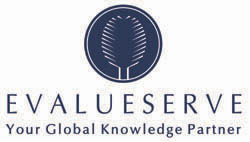
| Qualit Datamatics QD is a private owned organisation dedicated to technology transfer, in various countries where inbalances in development between urban and rural areas exist. Such imbalances hamper the national development due to the wastage of human and natural resources. By the acceptance and use of innovative technologies, this situation may be redressed. This assumption is based on the observation that human behavior changes, when new technologies are accepted and absorbed. In other words: once accepted, innovative technologies can cause social innovation. It is QD’s goal to select technologies which are innovative, attractive, maintenance free, modularized (with local construction components), solving immediate problems, and that can be operated in a decentralized way (= effective management).The technology sectors QD has choosen are water, biogas, wind energy systems, dairy, light, automotive and innovative decision support systems on urban planning for rural and urban areas. www.jagbandhan.com |
Futurist Portrait: James Canton

James Canton, Futurist, Author and Keynote Presenter, Institute for Global Futures, a San Francisco based think tank that forecasts innovations and trends. IGF provides keynote presentations, futures research services, and strategy consulting to the Fortune 1000, associations and governments.
For over 30 years, James Canton has been insightfully predicting the key trends that have shaped our world. He is a leading authority on future trends in innovation. He is the author of The Extreme Future: The Top Trends That Will Reshape the World in the 21st Century, Dutton 2006, and Technofutures: How Leading-Edge Innovations Will
Transform Business in the 21st Century, Next Millennium Press, 2004.
Dr. Canton is CEO and Chairman of the Institute for Global Futures, a leading think tank he founded in 1990 that advises business and government on future trends. He advises the Global Fortune 1000 on trends in innovation, financial services, health care, population, life sciences, energy, security, workforce, climate change and globalization. From a broad range of industries, clients include: IBM, BP, Intel, Philips, General Electric, Hewlett Packard, Boeing, FedEx, and Proctor & Gamble. He is a Senior Fellow at the Center for Research in Innovation at the Kellogg School of Management and serves on Motorola’s Visionary Advisory Board. He has advised three White House Administrations, the National Science Foundation and MIT’s Media
Lab, Europe.
Recognized as “one of the top presenters in the 21st century” by Successful Meetings Magazine, Dr. Canton is a highly sought-after keynote presenter. .
A frequent guest of the media, Dr. Canton is a commentator on CNN. He was named “the Digital Guru” by CNN and “Dr. Future” by Yahoo. Dr. Canton’s media coverage has included CNBC, Fox, PBS, ABC, Fortune, The Wall Street Journal, Bloomberg Report, The New York Times, US News and World Report, CEO, CIO and CFO Magazines. His Global Futurist blog is followed by a world-wide audience.
Part 1
Agenda
| The next Season Event is on Thursday, July 3 Taste of Diversity – the future of INDIA Registration: 18:30-19:00, Conference: 19:00-21:15, Buffet: 21:15-23:30 Tickets also include Indian dishes and some drinks! Location: Cultuurhuis Diamantslijperij, Tolstraat 129, 1074 VJ Amsterdam former Royal Asscher Diamond Factory 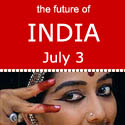 |
Club of Amsterdam Open Business Club
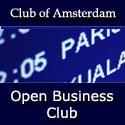
Club of Amsterdam Open Business Club
Are you interested in networking, sharing visions, ideas about your future, the future of your industry, society, discussing issues, which are relevant for yourself as well as for the ‘global’ community? The future starts now – join ouronline platform …








Customer Reviews
Thanks for submitting your comment!